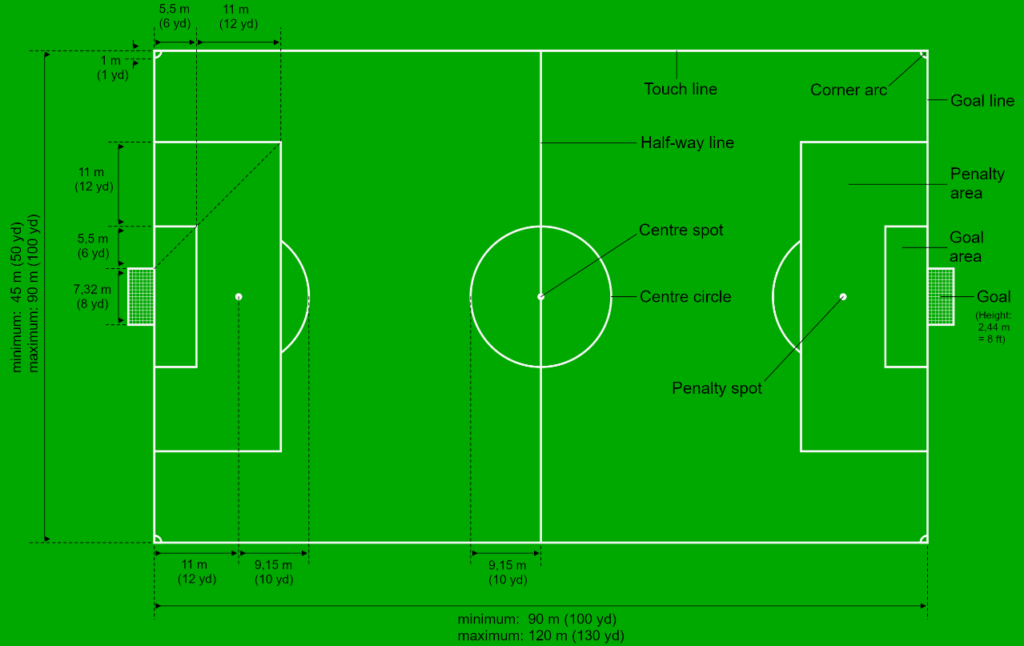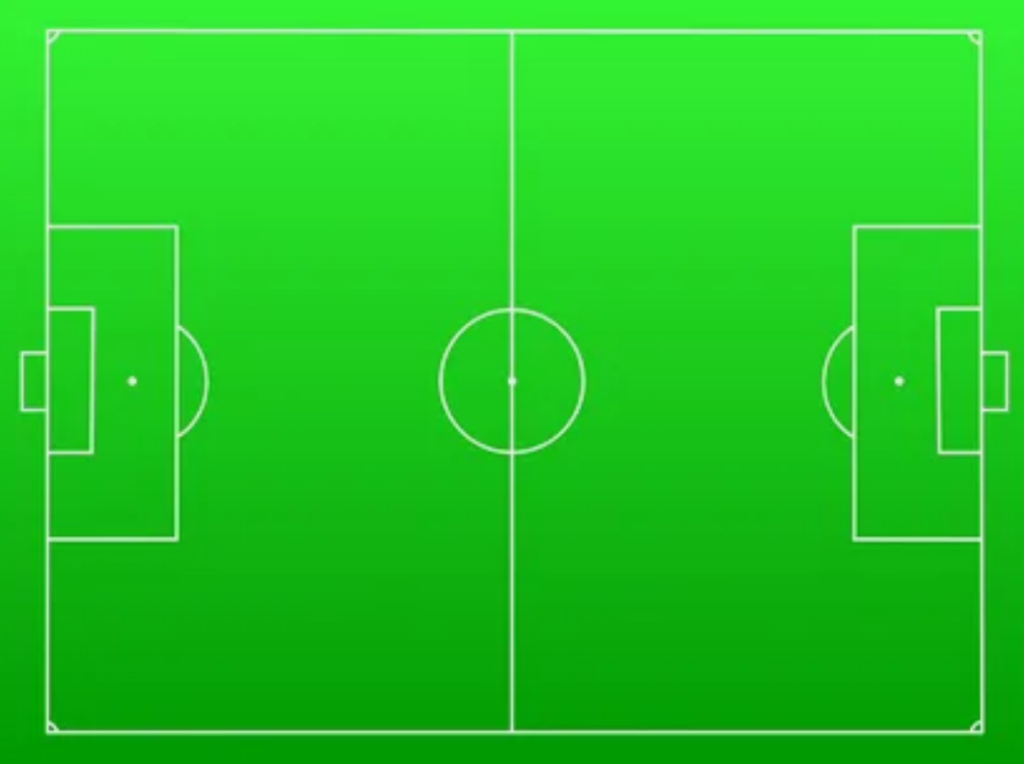A standard soccer field measures 120 to 150 feet in width and 220 to 300 feet in length. Soccer fields vary in size depending on regulations and age groups. The dimensions are crucial for gameplay and player positioning, ensuring a fair and competitive match. Understanding the specific measurements of a soccer field is essential for players, coaches, and referees to adhere to the rules and regulations of the game accurately.
Whether it’s a youth game, high school match, or professional-level play, knowing the dimensions of the field is fundamental for effective gameplay and strategy implementation. Let’s delve deeper into the importance of soccer field dimensions and how they impact the overall game experience.
Soccer Field Dimensions in Feet

Standard Soccer Field Size- Soccer Field Dimensions in Feet
Soccer, also known as football in many parts of the world, is played on a standardized field with specific dimensions. The size of a standard soccer field is crucial for the game’s regulation and fair play. Understanding the dimensions of a soccer field is essential for players, coaches, and fans alike. Let’s delve into the standard soccer field size and its key measurements.
Length of The Field- Soccer Field Dimensions in Feet
The length of a standard soccer field ranges between 100 yards and 130 yards, which translates to 300 feet to 390 feet. This length is consistent for both international and domestic soccer competitions, ensuring uniformity and fairness in the game.
Width of The Field
When it comes to the width of a soccer field, it typically spans between 50 yards and 100 yards, equivalent to 150 feet to 300 feet. The width is equally important as it impacts the flow of the game and strategic gameplay for teams.
Variations In Field Dimensions
Soccer fields come in various sizes, and the dimensions can vary based on different factors such as the level of play, available space, and regional preferences. Understanding the variations in field dimensions is crucial for players, coaches, and field managers to ensure a suitable playing environment for the game.
Regulations For Field Sizes
Regulations for soccer field dimensions are established by governing bodies such as FIFA and local federations. The standard size for a soccer field is approximately 100-130 yards in length and 50-100 yards in width. High school soccer field dimensions in feet are typically around 360 feet in length and 225 feet in width. These regulations ensure a consistent playing area across different competitions and levels of play, from youth to professional leagues.
Customization Options
While there are standard regulations for soccer field dimensions, there are also customization options available. Field managers and organizers may adjust the size of the field to accommodate space limitations or specific playing preferences. This flexibility allows for variations in soccer field size in meters based on the available area, ensuring that the game can be played in diverse settings while maintaining the essential elements of the sport.
Professional Soccer Field Sizes
Fifa Regulations
FIFA, the governing body of international soccer, sets specific regulations for soccer field dimensions.
Major League Soccer (MLS) Standards
The Major League Soccer (MLS) in the United States adheres to its own set of standards for soccer field sizes.
Youth Soccer Field Sizes
Discover the varying youth soccer field sizes in feet, essential for optimizing gameplay and player development. Understand the dimensions to ensure an ideal and safe playing environment for young athletes. Explore the specifics of soccer field dimensions to enhance youth soccer experiences.
Age-appropriate Field Dimensions
Youth soccer is a popular sport that is enjoyed by children of all ages. As children grow and develop their skills, they require different field sizes that are appropriate for their age group. The FIFA soccer field dimensions are 100-130 yards long and 50-100 yards wide. However, youth soccer field dimensions in feet vary based on the age group of the players.

Small-sided Game Fields
For younger children, small-sided game fields are recommended. These fields are smaller than standard soccer fields and are designed to accommodate fewer players. The field size for U6 and U8 age groups is typically 20-30 yards wide and 30-40 yards long. This smaller field size allows players to develop their skills in a more controlled environment.
Field Sizes For Older Children
As children get older, the field sizes increase to accommodate their growing skills and abilities. For U10 and U12 age groups, the field size increases to 50-80 yards wide and 70-100 yards long. U14 and U16 age groups use a field size of 100-130 yards long and 50-100 yards wide, which is the same as the FIFA soccer field dimensions. When it comes to youth soccer field sizes, it is important to consider the age group of the players and their skill level. Providing age-appropriate field dimensions allows children to develop their skills in a safe and controlled environment. Whether it’s a small-sided game field or a full-size soccer field, providing the right size field helps children to develop their skills and have fun playing the game of soccer.
Impact of Field Dimensions on Gameplay
The dimensions of a soccer field in feet have a significant impact on gameplay, affecting the pace, strategy, and scoring opportunities. A larger field encourages more running and passing, while a smaller one promotes tighter defense and quicker transitions. The field size plays a crucial role in shaping the dynamics of a soccer match.
Impact of Field Dimensions on Gameplay Soccer field dimensions has a significant impact on the gameplay, influencing tactical considerations and player development. The size of the field can affect the strategies and skills utilized by players, as well as the overall flow and dynamics of the game.
Tactical Considerations
The dimensions of the soccer field play a crucial role in shaping the tactical approach of teams. A larger field encourages a more expansive style of play, with an emphasis on spreading out and creating space. Conversely, a smaller field can lead to a more compact and defensive approach, as teams look to restrict the available space for their opponents.
Player Development
The size of the soccer field also impacts the development of players. A larger field promotes aerobic endurance and the ability to cover more ground, while a smaller field can enhance technical skills and close control. This variation in field dimensions can influence the type of players that are developed within a particular environment, shaping their playing style and abilities. In conclusion, the dimensions of a soccer field have far-reaching implications for the game, influencing tactical strategies and player development. By understanding the impact of field dimensions on gameplay, teams, and players can adapt their approach to maximize their performance on different-sized fields.
Historical Evolution of Soccer Field Sizes
The historical evolution of soccer field sizes has played a significant role in shaping the sport as we know it today. Over time, the dimensions of soccer fields have undergone several changes, impacting the style of play and strategy employed by teams. Understanding the historical evolution of soccer field sizes provides valuable insight into the development of the game and its influence on playing styles.
Changes Over Time
Throughout history, the dimensions of soccer fields have evolved to accommodate various factors such as player safety, game strategy, and the advancement of the sport. From the early days of soccer to the modern era, the size of the soccer field has seen modifications, leading to the establishment of standardized dimensions by governing bodies like FIFA. These changes have been instrumental in shaping the way the game is played at different levels, from youth soccer field dimensions in feet to professional arenas.
Influence on Playing Styles
The alterations in soccer field sizes have directly influenced the playing styles adopted by teams. Smaller fields encourage a more compact and aggressive style of play, while larger fields promote expansive and possession-based strategies. These variations in dimensions have also impacted the tactical approaches employed by coaches and players, leading to diverse and dynamic gameplay across different soccer field sizes by age and competitive levels.
Future Trends In Soccer Field Dimensions
Soccer field dimensions in feet are a critical aspect of the game, with FIFA setting standard dimensions between 100-130 yards in length and 50-100 yards in width. Understanding these dimensions is crucial for players, coaches, and field maintenance. Stay updated with the latest trends to ensure optimal playing conditions.
Soccer field dimensions have remained relatively constant for many years, but there are some exciting future trends to consider. These include technological innovations and environmental factors that could impact the size and shape of soccer fields in the coming years.
Technological Innovations
The use of technology in sports is constantly evolving, and soccer is no exception. As technology becomes more advanced, we may see changes in the size and shape of soccer fields to accommodate innovations. For example, virtual reality training and analysis tools could require larger fields to allow for more movement and interaction. Additionally, new sensors and tracking technology could lead to smaller fields, as players can cover more ground with greater accuracy and efficiency.

Environmental Factors
As concerns about climate change continue to grow, soccer field dimensions may be impacted by environmental factors. For example, rising sea levels could lead to changes in coastal soccer fields, while extreme weather events could require fields to be reconfigured to better withstand harsh conditions. Additionally, water scarcity and drought could lead to smaller fields, as less water is available for irrigation and maintenance. In conclusion, the future of soccer field dimensions is likely to be shaped by a range of technological and environmental factors. While the basic dimensions of soccer fields are unlikely to change dramatically, we can expect to see some interesting modifications and adaptations as the sport continues to evolve.
Conclusion
Understanding soccer field dimensions in feet is crucial for players, coaches, and fans. Proper field size impacts game strategy and player performance. By knowing the dimensions, you can appreciate the game even more. Stay informed and enjoy the beautiful game of soccer.

